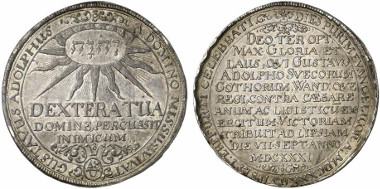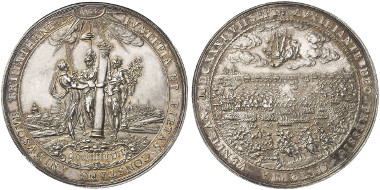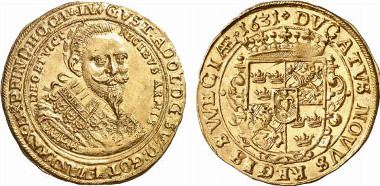translated by Annika Backe
While Tilly retreated from devastated Magdeburg, the troops of Gustavus Adolphus overran wealthy Mecklenburg where Wallenstein preferred leaving his provisions to the enemy to giving them to the imperial troops that were not subjected to his command. From Mecklenburg, Gustavus Adolphus headed for Hesse where the Hessian landgrave joined him. After this diplomatic victory the Swedes turned to Saxony which had not been affected by the turmoil of war that much and therefore still possessed rich resources.
Matthäus Merian, Merseburg, 1650. Source: Wikicommons.
Gustavus Adolphus captured Merseburg. Hans Georg von Arnim, the military commander of the Protestant troops, realized that he was militarily powerless against the superiority of the enemy and asked – or compelled, to be more specific – his employer John George of Saxony on September 11, 1631, to form an alliance with Gustavus Adolphus. That was just in time before Tilly and his still starving soldiers took the Pleißenburg, a fortress in close vicinity of Leipzig, on September 14, 1631. Only 40 kilometers away, the Swedish troops and the Protestant army united. There was no way out for Tilly. He was forced to engage in battle near Breitenfeld, six kilometers north of Leipzig, on September 18, 1631.
Erfurt. Under Gustavus II Adolphus. Reichsthaler, 1631. Purim thaler on the Victory on the Battle of Breitenfeld. Auction sale Künker 223 (2013), 345.
Gustavus Adolphus had brought 13,000 men and powerful artillery from Sweden with him. Measured against the huge army of Wallenstein that was not all that much. Yet both the Swedish infantry as well as the cavalry were considerably better trained than anything Germany had ever witnessed before. Gustavus Adolphus had aligned his soldiers to a new, more movable formation, with small squares of cavalrymen and shooters forming a gridiron pattern. These small units were better equipped to counter flank attacks.
Battle of Breitenfeld in a contemporary depiction, 1631. Source: Wikicommons.
Thanks to a new kind of exercise, the Swedes of Gustavus Adolphus were able to shoot in a staggered way. They reloaded their weapons once the other members of their unit were being shooting. That way, in the time it took his German opponent to make a single shot, a Swedish soldier could shoot about three times, which did pay off in the Battle of Breitenfeld.
Silver medal 1631 by S. Dadler on the Victory on the Battle of Breitenfeld. Auction sale Künker 261 (2015), 5096.
While Tilly successfully drove back the Saxon army and John George, who was present at the battle, retreated rather ingloriously, the Swedish troops managed to wipe out the Catholic army almost completely. The members of only four regiments escaped with their lives. 12,000 soldiers were killed, another 7,000 were taken captive. Tilly lost his entire artillery. Gustavus Adolphus thus achieved the first great victory for the Protestant cause and proved that it was possible to defeat the Habsburg troops.
Johann Walter, Gustavus Adolphus in the Battle of Breitenfeld, 1632. Source:
Wikicommons.
With that strike, Gustavus Adolphus became the center of attention in all of Europe all of a sudden. He became the shining light of Protestantism. Nobody seemed to care anymore that it was the financial aid of Catholic Cardinal Richelieu that had made this marvelous victory possible in the first place. Since the beginning of 1631, Richelieu paid 20,000 reichsthaler twice a year in return for Gustavus Adolphus making war on the Habsburgs in Germany. The Swedish king never kept this alliance a secret. He who staged himself as spearhead of Protestantism was willing to form an alliance with any prince, no matter if he was a Protestant, a Catholic or a Calvinist, as long as he himself could meet the emperor in Vienna.
After the Battle of Breitenfeld, many expected Gustavus Adolphus to head directly to Vienna in order to compel the emperor to conclude peace. That was not in his interest, though. The Swedish king rather intended to increase his gain in territory and money. Gustavus Adolphus thus decided that the remnants of the Protestant army, led by Arnim, were to invade Silesia while he captured the wealthy territories in the middle of Germany.
Regensburg. Reichsthaler, 1633. On the Swedish-Protestant troops capturing the city of Regensburg. Auction sale Künker 238 (2013), 4581.
On October 2, 1631, the city of Erfurt surrendered. On October 18, Gustavus Adolphus took Würzburg. The prince-bishop did not waste time waiting whether or not the Swedish king would conquer his city. He fled to Regensburg where the prince electors were holding a meeting. When the participants heard that Gustavus Adolphus was on the march, no one stayed in the city to discuss how the Edict of Restitution could be modified. The ambassadors and electors scattered in all directions to make sure that their homes were safe.
Germany. Diocese of Mainz. Under Gustavus II Adolphus. Ducat, 1631. Auction sale Künker 139 (2008), 8187.
On November 10, Arnim managed to capture Prague that Wallenstein, in consultation with Gustavus Adolphus, gave up without a fight. The latter laid siege on Hanau the following day, then on Aschaffenburg on November 22, and on Frankfurt am Main on November 27, 1631. Frankfurt was the city the Swedish king billeted his congenial chancellor Axel Oxenstierna on, who was charged with organizing the administration of the conquered territories. Gustavus Adolphus, on the other hand, proceeded. At the gates of Heidelberg, he left young Duke Bernhard of Saxe-Weimar in charge of seizing the city on his behalf. He himself laid siege on Mainz on December 19, 1631.
Since July 4, 1631, when Gustavus Adolphus had set foot on Germany for the first time near Usedom, his power had increased enormously. Late in 1631, the Lion from the North possessed seven armies with 80,000 soldiers his allies had supplied him with. New amongst his allies were the dukes John George of Saxony, William and Bernhard of Saxe-Weimar, the landgrave of Hesse-Kassel, the duke of Brunswick-Lüneburg, the landgrave of Hesse-Darmstadt, the regent of Wuerttemberg, the margraves of Ansbach and Bayreuth, Nuremberg and the Franconian Circle as well as the dukes of Mecklenburg, which the emperor had unseated, and Frederick V of the Palatinate.
It had taken less than two years for the fortunes of war to turn.
Read about the triumphal march of the Swedish king and the intervention of Wallenstein in the next episode.
All parts of the series can be found here.












